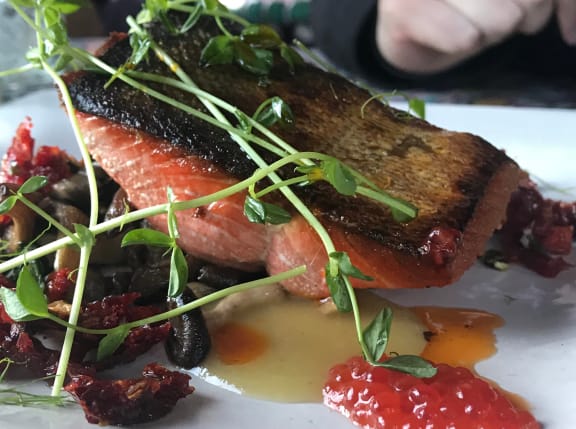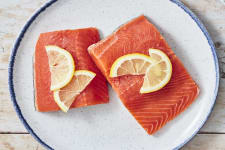In addition to being one of our nation's most incredible natural treasures, there's a good reason people everywhere are drawn to the wonder of Alaska. The wild landscape, abundant resources, and unique rhythms of this magical place have created a history and a set of culinary traditions that are vastly different than anything the Lower 48 is used to encountering.
50 Shades of Pink
The art of maintaining, harvesting, and preparing wild Alaskan salmon has been perfected over dozens of generations in the state of Alaska. Whether it’s king, sockeye or coho salmon, no one knows how to handle this lean protein better than an Alaskan. To make a salmon harvest last through the dead of a long winter, Alaskans have long known how to cure, pickle, smoke, and candy their catch. Eaten fresh off the boat in the summertime, salmon is fried simply in a hot pan or grilled over an open flame.
Sustainability is Law
A proper Alaskan knows not only how to make their haul of salmon last the year, but also how to preserve it for generations to come. As one of the state’s prized resources, the livelihood of Alaskans depends on their collective stewardship of this incredible fish, as it is not only the second largest sector of the state economy but also one of the key foods that has fed local fisherman for millennia.
Because of that, sustainability is literally a part of the state constitution, making Alaska a standout in American sustainability and governance. The state realized decades ago that failing to maintain its natural resources would end a long and proud tradition of self-reliance. In order to uphold the mandate of sustainable management of fish, game and land, the state has taken countless measures to maintain clean and safe habitats for its wildlife. There are also strict quotas on just about everything that can be taken from the land to prevent the overharvesting of any of Alaska’s replenishable resources.
Food Cycle Connection
In the warm, sunny summers, the fields and mountains are blanketed wild berries while the icy seas are abundant with salmon; local communities pick these berries and fishermen harvest these migrations of fish, knowing that what is gathered now must be enough to sustain oneself through the frigid winters. Being so involved in the harvest of locally-sourced food forges a great bond between humans and the land that nourishes them. Even today, Alaskans proudly embrace the tradition of living in tandem with the land.
Berries
No one knows why — perhaps it’s the extreme northerly sun and the pristine land — but the antioxidant capacity of Alaskan berries is significantly higher than berries from the contiguous United States. One study found that lingonberries grown in Alaska had over eight times the presence of antioxidants compared with conventionally-grown berries from the outside of the state; another source cited statistics that wild Alaskan blueberries are up to 10 times more concentrated in antioxidant content than the common blueberry.
Native Influence on Food & Cooking
Though the indigenous traditions of enjoying pseudo-fermented meats and seafoods doesn’t appeal to the modern palate, some of these culinary treasures have been adapted to the modern palate. A sort of traditional ice cream called akutaq, a dish that is made with snow and whipped seal oil or wild game lard, could be mixed with berries and even fish; nowadays, the dish is often made with shortening and sweetened with sugar.
Beyond specific recipes, the indigenous traditions of preservation are found in curing, drying, freezing and fermenting both plant-based and animal-based foods.
Moose Meat & Reindeer Sausage
Both reindeer and wild moose are integral parts of the Alaskan diet. The animals have been hunted for centuries by indigenous tribes as well as more recent settlers, a tradition that is still strong to this day. By state law, all meat from a hunted animal must be made into food; even roadkill is salvaged as sustenance, a testament to how serious Alaskans are about honoring their natural resources, never taking them for granted.
Summer Size
The land of the midnight sun causes vegetables to grow to freakish sizes through the constant input of solar energy — nearly 20 hours each day in the peak of summer. “Some things [are so big], you can’t even recognize what they are,” described the superintendent of the Alaska State Fair in an interview with NPR.
Home Sweet Homer
Arron Kallenberg, the founder of Wild Alaskan Seafood, has had fresh-caught fish on his mind for as long as he can remember: Homer, the “Halibut Fishing Capital of the World,” is his hometown. Located on the very tip of Alaska’s Kenai Peninsula, about 200 miles southwest of Anchorage, Homer is a hip little town that draws foodies with its cozy restaurants and locally-sourced cuisine; some foodies even liken food culture to something you’d expect to find in Louisiana. It’s home to the wood-fired Two Sisters Bakery and the legendary Salty Dawg Saloon, an old turn of the 20th century cabin (actually, the first one ever built in Homer) that is a favorite local watering hole whose interiors are bedecked in thousands upon thousands of dollar bills.
Red King Crab
Alaskan red king crabs are some of the largest crustaceans to make it to dinner plates around the world. The male king crabs can have leg spans as expansive as five feet across with carapaces nearly a foot in length, making for a monstrous but tasty dinner for humans as well as predators like cod, halibut, and even other king crabs.
Sourdough
In the remote reaches of Alaska, having access to fresh, leavened bread historically depended upon a person’s ability to keep a sourdough starter alive through a long and frosty winter. Sourdough legend has it that Alaskan miners used to sleep with their sourdough starters in order to keep the yeasts warm enough to survive.
That winter of survival of both of sourdough as well as the baker has spawned some contemporary slang; nowadays, if you manage to spend an entire winter residing in Alaska, you’ll have earned enough respect for people to start calling you a “sourdough.”






